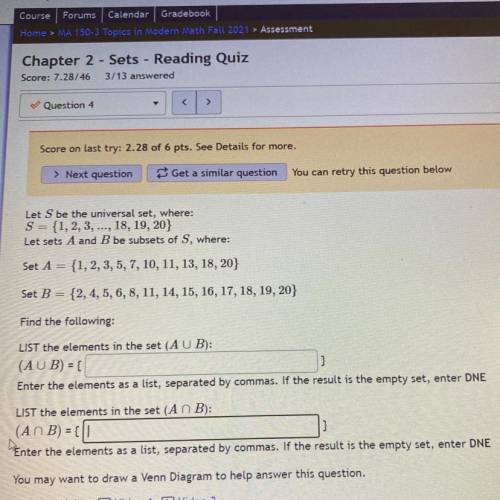Let S be the universal set, wiere:
S= {1, 2, 3, ..., 18, 19, 20}
Let sets A and B be subsets...

Mathematics, 10.09.2021 19:50 KennyOaks6230
Let S be the universal set, wiere:
S= {1, 2, 3, ..., 18, 19, 20}
Let sets A and B be subsets of S, where:
Set A=
= {1, 2, 3, 5, 7, 10, 11, 13, 18, 20}
Set B = {2, 4, 5, 6, 8, 11, 14, 15, 16, 17, 18, 19, 20}
Find the following:
LIST the elements in the set (A U B):
(AU B) = {
Enter the elements as a list, separated by commas. If the result is the empty set, enter DNE
LIST the elements in the set (AN B):
(AN B) = {
Enter the elements as a list, separated by commas. If the result is the empty set, enter DNE
You may want to draw a Venn Diagram to help answer this question.


Answers: 1


Another question on Mathematics

Mathematics, 21.06.2019 15:00
Which sum or difference identity would you use to verify that cos (180° - ∅) = -cos ∅? a. sin (α -β) = sin α cos β – cos α sin β b. cos (α -β) = cos α cos β – sin α sin β c. cos (α -β) = cos α cos β + sin α sin β d. sin (α + β) = sin α cos β + cos α sin β
Answers: 2

Mathematics, 21.06.2019 17:20
Two language majors, anna and megan, took exams in two languages. anna scored 85 on both exams. megan scored 74 on the first exam and 85 on the second exam. overall, student scores on the first exam had a mean of 82 and a standard deviation of 4, and the second exam scores had a mean of 71 and a standard deviation of 13. a) to qualify for language honors, a major must maintain at least an 85 average across all language courses taken. so far, which of anna and megan qualify? b) which student's overall performance was better?
Answers: 2

Mathematics, 21.06.2019 18:20
17. a researcher measures three variables, x, y, and z for each individual in a sample of n = 20. the pearson correlations for this sample are rxy = 0.6, rxz = 0.4, and ryz = 0.7. a. find the partial correlation between x and y, holding z constant. b. find the partial correlation between x and z, holding y constant. (hint: simply switch the labels for the variables y and z to correspond with the labels in the equation.) gravetter, frederick j. statistics for the behavioral sciences (p. 526). cengage learning. kindle edition.
Answers: 2

Mathematics, 21.06.2019 20:00
Evaluate the discriminant of each equation. tell how many solutions each equation has and whether the solutions are real or imaginary. x^2 + 4x + 5 = 0
Answers: 2
You know the right answer?
Questions

Mathematics, 21.11.2019 04:31

Mathematics, 21.11.2019 04:31















Social Studies, 21.11.2019 04:31





